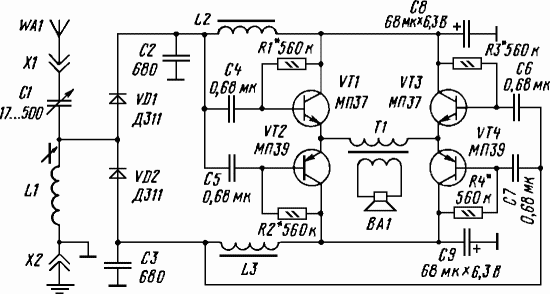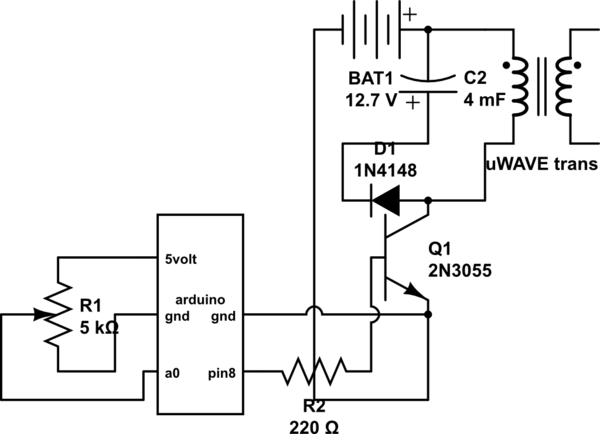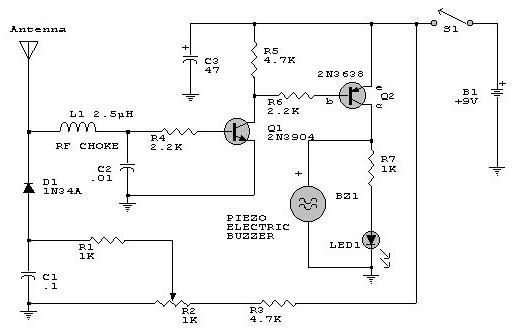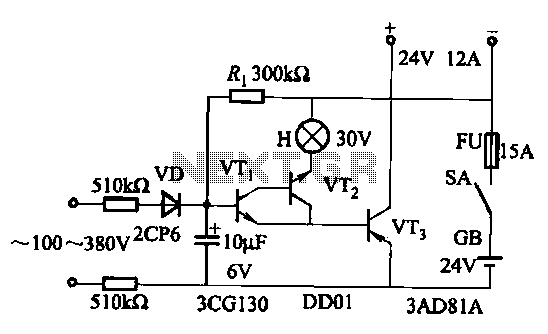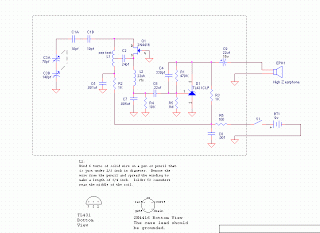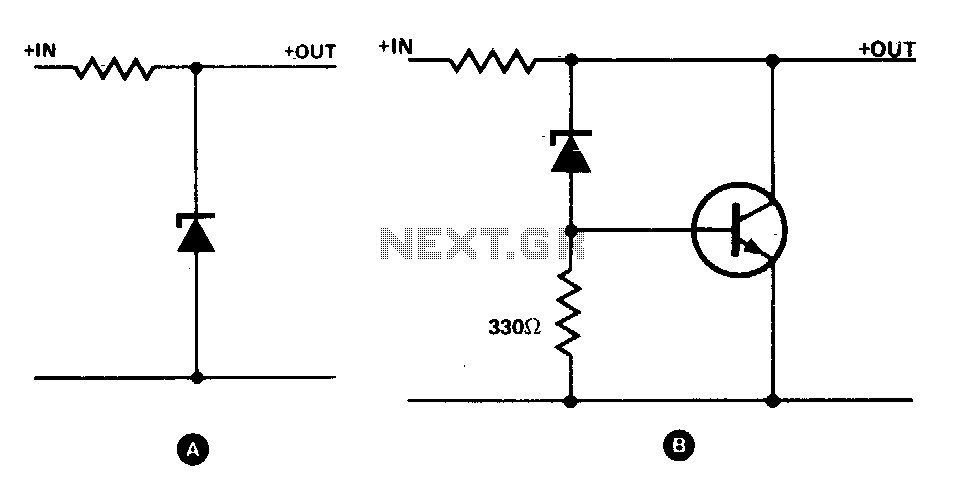
two transistor radio

This circuit is a simple one-transistor Audion type radio powered by a 1.5 V battery. It utilizes a pair of standard low-impedance headphones, wired in series to achieve a total impedance of 64 ohms. The power supply to the circuit is routed through the headphones, ensuring that unplugging the headphones will turn off the circuit. The Audion configuration allows the single transistor to handle both demodulation and amplification of the received signal. The sensitivity of the receiver is sufficient to use a 2-meter length of wire as an antenna. The antenna coil tap is located at one-fifth of the total winding on the ferrite rod. For further details regarding the antenna coil, refer to the article on Diode Radio for Low Impedance Headphones. This circuit is designed for receiving all AM transmissions, ranging from long-wave to shortwave.
The circuit operates on a basic principle of radio frequency signal reception and processing using a single transistor to minimize component count while maximizing efficiency. The transistor, typically an NPN type, is configured in a common emitter arrangement. The input signal from the antenna is coupled to the base of the transistor via a capacitor, allowing only the AC components of the radio signal to pass through while blocking DC voltage.
The audio output is taken from the collector of the transistor, which is connected to the headphones. The series connection of the headphones ensures that the circuit remains powered as long as the headphones are connected. When the headphones are unplugged, the circuit is effectively disabled, conserving battery life.
The antenna, a simple wire of 2 meters, acts as both a signal collector and a resonant element in conjunction with the antenna coil. The coil is wound around a ferrite rod to enhance inductance and improve reception quality. The tap point at one-fifth of the total winding allows for optimal coupling of the signal to the transistor, ensuring adequate gain and sensitivity.
To further enhance performance, the circuit may incorporate additional passive components such as resistors and capacitors for biasing the transistor and filtering unwanted frequencies. The design is particularly suitable for hobbyists and educational purposes, providing a practical introduction to radio electronics and the principles of AM signal reception. This circuit can effectively receive a wide range of AM broadcasts, making it a versatile tool for exploring radio technology.Here is a simple circuit for a one transistor Audion type radio powered by a 1. 5 V battery. It employs a set of standard low-impedance headphones with the headphone socket wired so that the two sides are connected in series thus giving an impedance of 64 ©. The supply to the circuit also passes through the headphones so that unplugging the headphones turns off the supply.
Using an Audion conguration means that the single transistor performs both demodulation and amplification of the signal. The sensitivity of this receiver is such that a 2 m length of wire is all that is needed as an antenna.
The tap on the antenna coil is at 1/5th of the total winding on the ferrite rod. For details of the antenna coil see the article Diode Radio for Low Impedance Headphones. This circuit is suitable for reception of all AM transmissions from long-wave through to shortwave. 🔗 External reference
The circuit operates on a basic principle of radio frequency signal reception and processing using a single transistor to minimize component count while maximizing efficiency. The transistor, typically an NPN type, is configured in a common emitter arrangement. The input signal from the antenna is coupled to the base of the transistor via a capacitor, allowing only the AC components of the radio signal to pass through while blocking DC voltage.
The audio output is taken from the collector of the transistor, which is connected to the headphones. The series connection of the headphones ensures that the circuit remains powered as long as the headphones are connected. When the headphones are unplugged, the circuit is effectively disabled, conserving battery life.
The antenna, a simple wire of 2 meters, acts as both a signal collector and a resonant element in conjunction with the antenna coil. The coil is wound around a ferrite rod to enhance inductance and improve reception quality. The tap point at one-fifth of the total winding allows for optimal coupling of the signal to the transistor, ensuring adequate gain and sensitivity.
To further enhance performance, the circuit may incorporate additional passive components such as resistors and capacitors for biasing the transistor and filtering unwanted frequencies. The design is particularly suitable for hobbyists and educational purposes, providing a practical introduction to radio electronics and the principles of AM signal reception. This circuit can effectively receive a wide range of AM broadcasts, making it a versatile tool for exploring radio technology.Here is a simple circuit for a one transistor Audion type radio powered by a 1. 5 V battery. It employs a set of standard low-impedance headphones with the headphone socket wired so that the two sides are connected in series thus giving an impedance of 64 ©. The supply to the circuit also passes through the headphones so that unplugging the headphones turns off the supply.
Using an Audion conguration means that the single transistor performs both demodulation and amplification of the signal. The sensitivity of this receiver is such that a 2 m length of wire is all that is needed as an antenna.
The tap on the antenna coil is at 1/5th of the total winding on the ferrite rod. For details of the antenna coil see the article Diode Radio for Low Impedance Headphones. This circuit is suitable for reception of all AM transmissions from long-wave through to shortwave. 🔗 External reference
